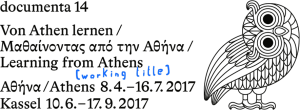During a press conference held at the Fridericianum in Kassel, Greece’s National Museum of Contemporary Art, Athens (EMST) and documenta 14 presented the multiple dimensions of their collaboration spanning both institutions as well as their founding cities. Katerina Koskina (Director of the National Museum of Contemporary Art, Athens) and Adam Szymczyk (Artistic Director of documenta 14) announced that documenta 14 in Athens will be hosted by and inhabit EMST as the largest venue of the exhibition. documenta 14 will in turn host EMST’s collection at the Fridericianum in Kassel, presenting a curated selection of the museum’s valuable public collection of Greek and international contemporary art, prior to the expected inauguration of the permanent display at EMST in Athens later this year.
At the core of the collaboration is a shared concern: How are art and its institutions made public and part of the common good? Since it was founded in 2000, the National Museum of Contemporary Art (EMST) has collected works by Greek and international artists from the 1960s to the present. During the past years, works of the growing collection were contextualized through exhibitions presented in numerous temporary spaces such as the Athens Concert Hall (Megaron), the Athens Conservatoire, as well as in the public space, as an important step to make the museum and its collection public despite the challenges EMST faced. In the meantime, preparations were made for a move into the museum’s permanent home in the former Fix Brewery on Syngrou Avenue. This move took place in 2015 and the future plan to fully open this quintessential public institution—making its building, its collection, and its exhibition program available to all who live in and come to Athens—was inaugurated by the program EMST in the World. Despite austerity measures, EMST managed to forge collaborations to show its collection in dialogue with works from other international museums and art institutions. Building on its nomadic life, EMST invigorates the Fix building with a dynamic program, but also takes this moment as a historic opportunity to pause and consider what it means to be a contemporary museum today.
documenta’s capacity to produce an exhibition at the forefront of contemporary art and theory is sustained by stable financial commitments from public funders such as the city of Kassel, the state of Hessen, and the German Federal Cultural Foundation. The history of this exhibition, however, reveals its ideological underpinnings as a West German institution, transformed after 1989 to encompass global art towards the present moment, in which it needs to carefully balance multiple aspects: its relationship to the international art market, its economic impact on the city of Kassel, and the importance of its accessibility to all publics versus the necessity to bolster the exhibition budget through income from ticket sales. It has become crucial for documenta to answer the question of what it means to be public today, on all levels—artistic, political, and financial. Adam Szymczyk’s proposal to organize documenta 14 in Athens and Kassel interrogates the position of the institution by reversing the role of host that it has grown so accustomed to, instead shaping an exhibition in a context where it is a guest, and where its calling card is an invitation for a shared Learning from Athens.
The exhibition at Fridericianum during documenta 14 in Kassel marks the first time that the collection of Greece’s National Museum of Contemporary Art is presented in Germany. The approach of Katerina Koskina and the curatorial team of EMST considers the collection vis-à-vis the long history of the Fridericianum, established in 1779 as the first public museum in mainland Europe, then becoming a library, and finally in its contemporary function as a Kunsthalle as well as, of course, the once ruinous birthplace of documenta in 1955. What is more, the Fridericianum’s history as a house of parliament of the short-lived Kingdom of Westphalia (1807–13)—the first parliamentary representation in the history of Germany—serves as inspiration for the presentation of the EMST collection as it becomes subject of international debate. As such, the collection shares stories, challenges prevalent histories and their protagonists, and engages politics through its commitment to preserving artworks and documenting the processes of their making.
The EMST building was designed in 1961 as a brewery by the visionary Greek modernist architect Takis Zenetos (1926–77) in collaboration with Margaritis Apostolidis (1922–2005)—a mighty four-story horizontal slab of concrete inserted into the city’s older fabric, with production lines visible from the street. The presentation of documenta 14 artists and artworks there is inspired by the sense of a libidinal economy, rethinking production, currencies, and flows as always social and always public. The full vertical span of the building is given over to the presentation of the documenta 14 exhibition in Athens and becomes exemplary among several collaborations with public institutions in the Greek capital—beginning with the Athens School of Fine Arts (ASFA) and extending to the Athens Municipality Arts Center at Parko Elefterias, where the Parliament of Bodies, documenta 14’s Public Programs, was launched in September 2016, as well as certain parts of the Benaki Museum complex, several archeological sites and museums, archives, institutions of higher learning, and the sites that embody the kind of learning that takes place on the street. The EMST building and the museum’s collection are made public, though not simultaneously and not in the same space, in keeping with the conditions of displacement that both EMST and documenta 14 currently work within.
A full list of venues of documenta 14 in Athens and Kassel will be released soon.


